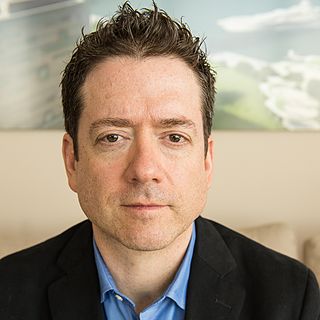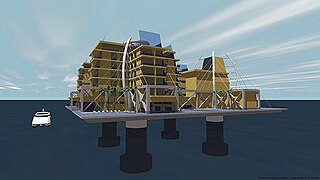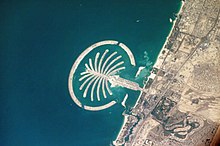
A port is a maritime facility comprising one or more wharves or loading areas, where ships load and discharge cargo and passengers. Although usually situated on a sea coast or estuary, ports can also be found far inland, such as Hamburg, Manchester and Duluth; these access the sea via rivers or canals. Because of their roles as ports of entry for immigrants as well as soldiers in wartime, many port cities have experienced dramatic multi-ethnic and multicultural changes throughout their histories.

Offshore construction is the installation of structures and facilities in a marine environment, usually for the production and transmission of electricity, oil, gas and other resources. It is also called maritime engineering.

Freedom Ship is a floating city project initially proposed in the late 1990s. The namesake of the project reflects the designer's vision of a mobile ocean colony, such that it is free from the property, municipal, or federal laws of any nation states. The project would not be a conventional ship, but rather a series of linked barges.
An artificial reef (AR) is a human-created freshwater or marine benthic structure. Typically built in areas with a generally featureless bottom to promote marine life, it may be intended to control erosion, protect coastal areas, block ship passage, block the use of trawling nets, support reef restoration, improve aquaculture, or enhance scuba diving and surfing. Early artificial reefs were built by the Persians and the Romans.

Underwater habitats are underwater structures in which people can live for extended periods and carry out most of the basic human functions of a 24-hour day, such as working, resting, eating, attending to personal hygiene, and sleeping. In this context, 'habitat' is generally used in a narrow sense to mean the interior and immediate exterior of the structure and its fixtures, but not its surrounding marine environment. Most early underwater habitats lacked regenerative systems for air, water, food, electricity, and other resources. However, some underwater habitats allow for these resources to be delivered using pipes, or generated within the habitat, rather than manually delivered.
Floating city may refer to:

Marine engineering is the engineering of boats, ships, submarines, and any other marine vessel. Here it is also taken to include the engineering of other ocean systems and structures – referred to in certain academic and professional circles as "ocean engineering".

In science fiction, floating cities and islands are a common trope, which range from cities and islands that float on water to ones that float in the atmosphere of a planet by purported scientific technologies or by magical means. While very large floating structures have been constructed or proposed in real life, aerial cities and islands remain in the realm of fiction.

Very large floating structures (VLFSs) or very large floating platforms (VLFPs) are artificial islands, which may be constructed to create floating airports, bridges, breakwaters, piers and docks, storage facilities, wind and solar power plants, for military purposes, to create industrial space, emergency bases, entertainment facilities, recreation parks, mobile offshore structures and even for habitation. Currently, several different concepts have been proposed for building floating cities or huge living complexes. Some units have been constructed and are presently in operation.

Seasteading is the concept of creating permanent dwellings at sea, called seasteads, in international waters outside the territory claimed by any government. No one has yet created a structure on the high seas that has been recognized as a sovereign state. Proposed structures have included modified cruise ships, refitted oil platforms, and custom-built floating islands.

Patri Friedman is an American libertarian, anarcho-capitalist, and theorist of political economy. He founded The Seasteading Institute, a non-profit that explores the creation of sovereign ocean colonies.
A seascraper, also known as a waterscraper, is a proposed large building which will function as a floating city. It would generate its own energy through wave, wind, current, solar, etc. and produce its own food through farming, aquaculture, hydroponics, etc. The term "Seascraper" is an analogous derivative of "Skyscraper".

The Cancún Underwater Museum is a non-profit organization based in Cancún, Mexico devoted to the art of conservation. The museum has a total of 500 sculptures, by a series of international and local sculptors, with three different galleries submerged between three and six meters deep in the ocean at the Cancún National Marine Park. The museum was thought up by Marine Park Director Jaime González Cano, with the objective of saving the nearby coral reefs by providing an alternative destination for divers. It was started in 2009 and officially opened in November 2010.

Joe Quirk is an American author originally from Westfield, New Jersey. His latest book is Seasteading: How Floating Nations Will Restore the Environment, Enrich the Poor, Cure the Sick, and Liberate Humanity from Politicians. Quirk is also president of the non-profit Seasteading Institute.

The Molinere Bay Underwater Sculpture Park is a collection of ecological underwater contemporary art located in the Caribbean sea off the west coast of Grenada, West Indies and was created by British sculptor Jason deCaires Taylor. In May 2006 the world's first underwater sculpture park was open for public viewing. Taylor's aim was to engage local people with the underwater environment that surrounds them using his works which are derived from life casts of the local community. He installed concrete figures onto the ocean floor, mostly consisting of a range of human forms, from solitary individuals to a ring of children holding hands, facing into the oceanic currents.

Blueseed was a Silicon Valley-based startup company and a seasteading venture to create a startup community located on a vessel stationed in international waters near the coast of Silicon Valley in the United States. The intended location would enable non-U.S. startup entrepreneurs to work on their ventures without the need for a US work visa (H1B), while living in proximity to Silicon Valley and using relatively easier to obtain business and tourism visas (B1/B2) to travel to the mainland.
Ocean development refers to the establishing of human activities at sea and use of the ocean, as well as its governance.

The Seasteading Institute(TSI) is a 501(c)(3) non-profit organization formed to facilitate the establishment of autonomous, mobile communities on seaborne platforms operating in international waters (a proposed practice called seasteading). It was founded by Wayne Gramlich and Patri Friedman on April 15, 2008.

Ephemerisle is an annual week-long gathering every July on the water in the Sacramento Delta.



























